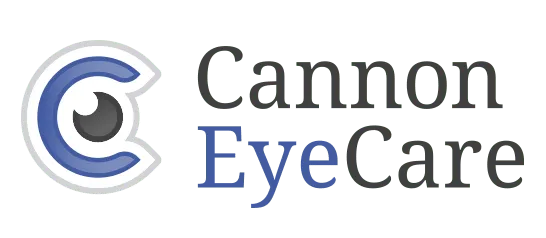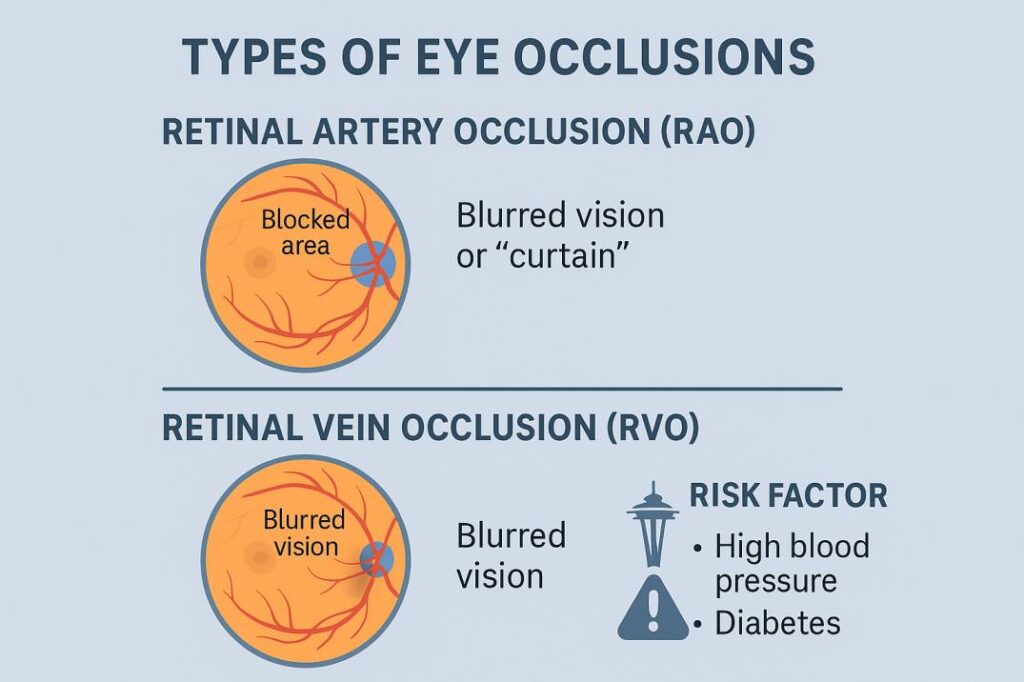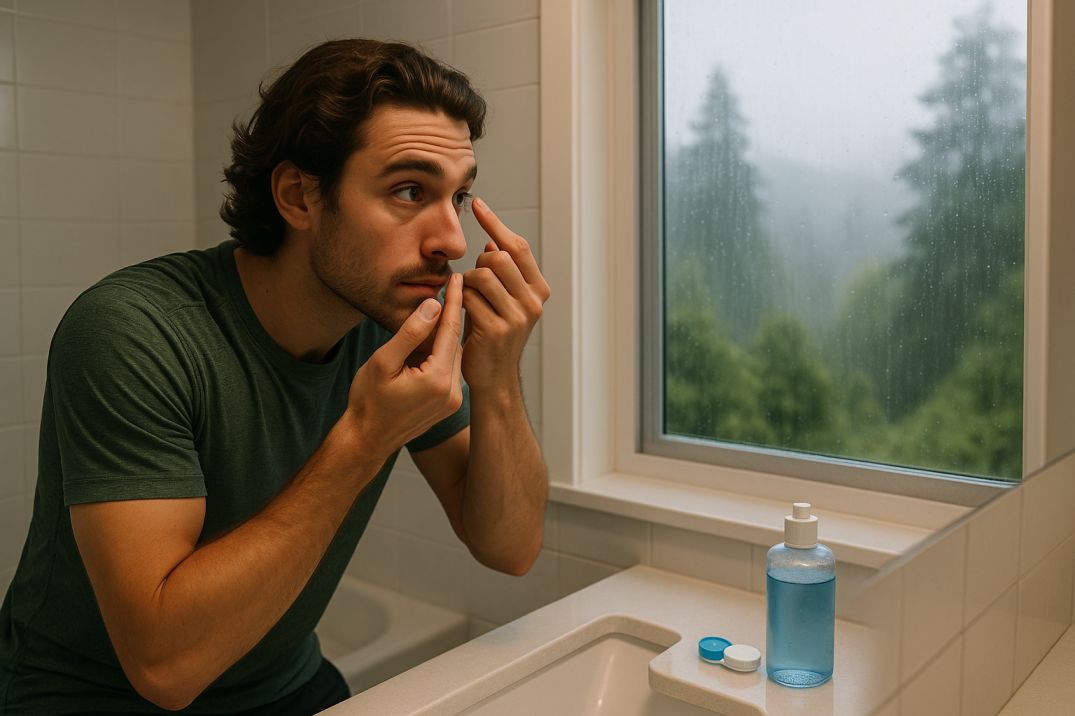Eye Occlusions
Eye Occlusions Explained: Seattle-Specific Risks
Eye occlusions occur when blood vessels in your retina get blocked, starving delicate eye tissues of oxygen. Picture a traffic jam on I-5 in Seattle—when critical routes clog, everything downstream suffers.
Two primary types threaten vision:
-
Retinal Vein Occlusions (RVO)
-
Central (CRVO): Main retinal drainage vein blocked
-
Branch (BRVO): Smaller vein obstructed
-
-
Retinal Artery Occlusions (RAO)
-
Central (CRAO): Main retinal supply artery blocked
-
Branch (BRAO): Smaller arterial branch affected
-
Why immediate care matters in Washington:
Eye occlusions impact ~2.14 per 1,000 Seattle-area residents yearly—more common than most realize. Without urgent treatment from an eye specialist, they often cause permanent vision loss.
Spot Eye Emergency Signs: When Seattle Residents Should Act
Critical symptoms needing same-day care:
-
Sudden painless vision loss in one eye
-
Severe blurring is unaffected by blinking
-
Dark spots or a “curtain” blocking vision
-
Complete peripheral vision disappearance
Gradual warning signs requiring evaluation:
-
Vision is dimming over days/weeks
-
Increasing difficulty reading or recognizing faces
-
New floaters or flashing lights
-
Distorted vision (straight lines appearing wavy)
Seattle-Specific Action Guide:
➤ Call 911 immediately for: Sudden complete vision loss
➤ Visit Cannon EyeCare within 24 hours for: Gradual vision changes
Our Seattle clinic maintains specialized emergency protocols for retinal issues—timing is critical to prevent permanent damage.
Your Eye Occlusion Risk: Seattle-Specific Factors
While retinal occlusions traditionally affect those over 50, Seattle’s 2023 eye health data reveals a concerning trend: 20% of cases now occur in patients under 50. This shift correlates with risk factors prevalent in our region’s tech workforce and lifestyle.
Key Medical Risks:
-
Hypertension (present in 60-80% of cases)
-
Diabetes (300-400% higher risk)
-
High cholesterol (especially with other conditions)
-
Glaucoma (increased eye pressure)
-
Blood clotting disorders
Lifestyle Contributors:
-
Smoking (doubles arterial occlusion risk)
-
Sedentary habits (common among Seattle office workers)
-
Sleep apnea
-
Dehydration (heightened risk during Seattle’s dry summers)
Emerging Young Adult Risks (2023 Study):
-
Oral contraceptives (15% of young female cases)
-
Inflammatory conditions (20.4% of under-50 cases)
-
Chronic stress (linked to Seattle’s competitive workplaces)
-
Vitamin D deficiency (critical in Pacific Northwest winters)
Why This Matters: These factors compound rapidly. If multiple apply to you, consult a Seattle retina specialist for a preventive evaluation.
Diagnosing Eye Occlusions: Your Seattle Clinic Experience
At Cannon EyeCare, our emergency diagnostic protocol follows 2024 AOA guidelines:
Step 1: Immediate Vision Assessment
-
Visual acuity testing (specialized eye charts)
-
Peripheral vision mapping
-
Pupil response evaluation
Step 2: Advanced Retinal Imaging
-
OCT Scan: Detailed cross-section of retina layers
-
Fluorescein Angiography: Blood flow mapping with safe dye
-
OCT Angiography: Non-invasive vessel imaging (no dye needed)
Step 3: Systemic Health Screening
Because 70% of eye occlusions indicate underlying conditions:
-
Blood Tests:
-
Diabetes screening (HbA1c)
-
Cholesterol panel
-
-
Cardiac Evaluation:
-
EKG rhythm analysis
-
Blood pressure trending
-
Carotid ultrasound (if indicated)
-
Your Diagnosis Decoded:
-
Non-ischemic: Better prognosis – often treated with anti-VEGF injections
-
Ischemic: Urgent intervention – may require laser treatment
Cutting-Edge Eye Occlusion Treatments in Seattle
Anti-VEGF Injections: Precision Therapy
Most retinal occlusion patients in Seattle receive painless anti-VEGF injections – the gold standard treatment. Despite sounding intimidating, patients report no discomfort during this highly effective procedure.
Medication Options at Cannon EyeCare:
-
Aflibercept (Eylea): First-line treatment (every 6-8 weeks)
-
Ranibizumab (Lucentis): Monthly initial dosing
-
Bevacizumab (Avastin): Cost-effective alternative
Treatment Experience:
-
Preparation: Numbing drops eliminate sensation
-
Procedure: Under 30 seconds per eye
-
Recovery: Brief monitoring in our Seattle clinic
-
Follow-up: Visits every 4-6 weeks initially
Revolutionary Surgical Breakthroughs
A landmark 2025 study validated central retinal artery catheterization – now available at Seattle’s leading eye centers. This technique restores vision even 40+ hours post-symptom onset, shattering previous time limits.
Surgical Outcomes:
-
88% significant vision improvement
-
90-minute average procedure
-
2-4 week recovery
Advanced Alternatives:
-
Ozurdex Implant: Slow-release steroid (3-6 months efficacy)
-
Subthreshold Micropulse Laser: Safer alternative preserving retinal tissue
Life After Eye Occlusions: Your Seattle Recovery Roadmap
Navigating recovery with our 2025 vision rehabilitation protocols:
Recovery Timeline
-
First 48 Hours:
✓ Vision fluctuations are normal
✓ Strictly follow post-treatment care
✓ Watch for infection signs (pain/discharge increase) -
Weeks 1-4:
✓ Gradual vision improvement begins
✓ Critical follow-up appointments
✓ Mild light sensitivity is common -
Months 2-6:
✓ Peak improvement period
✓ Treatment frequency reduces
✓ Long-term outlook clarified
Seattle-Specific Living Strategies
Driving & Transportation:
-
Washington requires ≥20/40 vision in one eye for a driver’s license
-
Utilize Seattle’s robust transit during recovery:
→ King County Metro buses
→ Link Light Rail
→ Washington State Ferries -
Rideshares (Uber/Lyft) bridge independence gaps
Workplace Adaptation:
-
Leverage Seattle tech company accommodations:
• JAWS/ZoomText screen readers
• Anti-glare screen filters
• Ergonomic lighting adjustments -
Flexible scheduling for Cannon EyeCare appointments
Prevent Eye Occlusions: Seattle-Specific Protection Strategies
Evidence-backed approaches to safeguard your vision:
Core Prevention Protocols
-
Blood Pressure Control:
Maintain ≤130/80 mmHg (reduces risk 50%)
Seattle advantage: Walk the Burke-Gilman Trail or Discovery Park -
Diabetes Management:
Keep HbA1c <7% via:
✓ Regular monitoring
✓ Fresh produce from Pike Place Market
✓ Consistent meal timing -
Cardiovascular Care:
Annual cholesterol checks
Heart-healthy PNW diet (wild salmon, local berries)
Stress reduction: Try Seattle Community Yoga classes
The Pacific Northwest Advantage
Vitamin D Optimization:
Critical in our climate! Supplementation combats deficiency linked to a 30% higher occlusion risk.
Year-Round Activity Guide:
-
Rainy Months: Indoor climbing at SBP Seattle
-
All Season: Lap swim at Medgar Evers Pool
-
Winter Hikes: Snow-free trails like Cougar Mountain.
Eye occlusions are serious—but with early detection, advanced treatment, and Seattle-specific prevention strategies, lasting vision loss can often be avoided. Whether you’re noticing subtle changes or experiencing sudden symptoms, acting quickly is the key to preserving your sight.
Take the next step:
Don’t wait until it’s too late. Schedule an emergency evaluation or preventive screening today at Cannon EyeCare—Seattle’s trusted leader in retinal care.
FAQs
-
Recovery typically takes 5-6 months with treatment. Vision improvement starts within weeks but continues gradually over several months




